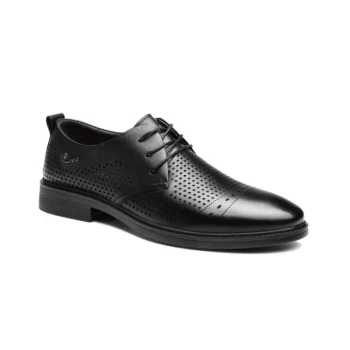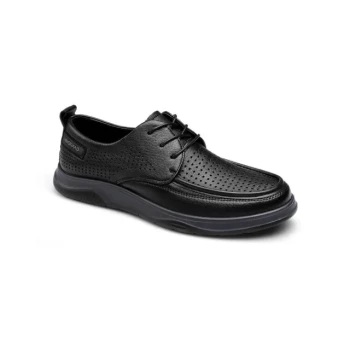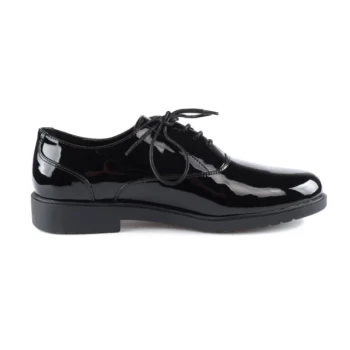Originally a functional outdoor shoe, the Brogue began its life in the bogs of Ireland and Scotland. The distinctive perforations, known as broguing, were not for decoration but were practical holes designed to drain water after crossing wet terrain. Over time, these functional elements were adopted by country gentlemen and evolved into the ornamental details that define the shoe's character today, making it a versatile staple for both business and smart-casual attire.
The key to understanding the Brogue is recognizing its journey from rugged utility to refined style. The amount of decorative perforation on the shoe directly correlates to its level of formality—the more broguing, the more casual the shoe.
The Evolution from Utility to Ornament
The history of the Brogue is a perfect example of function evolving into fashion. What started as a necessity for farmers became a hallmark of classic menswear.
The Origins in the Bogs
The name "Brogue" comes from the Gaelic word bróg, meaning shoe. Its design was a direct response to the wet, marshy landscape of its origin.
Early versions were simple, untanned hides with perforations that allowed water to drain out, preventing the wearer's feet from being constantly soaked and helping the shoe dry faster.
The Transition to High Fashion
In the early 20th century, this practical country walking shoe was adopted by landowners and country gentlemen. As it gained popularity, the design was refined.
The perforations became smaller and more intricate, shifting from a practical feature to a purely decorative one. This transition allowed the Brogue to move from the countryside into the city, becoming a fashionable choice for business and social occasions.
Decoding Brogue Styles by Formality
Not all Brogues are created equal. The pattern and extent of the perforations define the style and its appropriate place in your wardrobe.
Full Brogue (The "Wingtip")
The Full Brogue, famously known as the Wingtip, is characterized by a pointed toe cap with extensions called wings that run along the sides of the shoe.
This style is the most heavily decorated and is therefore considered the most casual of the classic Brogue types. It is an excellent choice for smart-casual wear.
Semi-Brogue (or Half Brogue)
The Semi-Brogue features a perforated toe cap but lacks the "wing" extensions of the Full Brogue. It has a cap-toe appearance with decorative broguing along the edge and often in the center (a medallion).
It strikes a perfect balance between decoration and formality, making it highly versatile for both business suits and more relaxed outfits.
Quarter Brogue
The Quarter Brogue is the most formal and understated of the family. Like the Semi-Brogue, it has a standard cap toe.
However, the perforations are limited to the edge of the toe cap, with no medallion on top. Its clean lines make it the most suitable Brogue to wear with business suits.
Understanding the Trade-offs and Common Pitfalls
While incredibly versatile, the Brogue is not a universal solution. Understanding its limitations is key to wearing it well.
Misjudging the Occasion
The Brogue is never appropriate for black-tie or white-tie events. Its rustic, outdoor heritage makes it fundamentally too informal for these strict dress codes, which require a simple patent leather shoe.
The Color and Material Mismatch
A shoe's color and material significantly impact its formality. A light tan suede Brogue is inherently casual and works well with jeans or chinos, but it will look out of place with a dark worsted wool business suit.
Conversely, a black leather Quarter Brogue pairs perfectly with formal tailoring but can feel too severe for a relaxed weekend outfit.
Ignoring the Sole
The construction of the sole is a critical detail. A thick, rubber commando sole signals a casual, rugged shoe meant for harsher weather and informal settings. A sleek, thin leather sole is more refined and appropriate for business and dressier occasions.
Making the Right Choice for Your Goal
Selecting the right Brogue depends entirely on its intended purpose within your wardrobe.
- If your primary focus is formal business wear: Choose a black or dark brown Quarter Brogue with a slim leather sole for a clean, professional look.
- If your primary focus is maximum versatility: An oxblood or dark brown Semi-Brogue is your best investment, easily dressing up with a suit or down with chinos.
- If your primary focus is a distinctive smart-casual style: A tan Full Brogue (Wingtip) provides a classic yet confident statement that pairs perfectly with denim, tweeds, and blazers.
By understanding its functional past, you can confidently deploy the Brogue as a timeless cornerstone of modern style.
Summary Table:
| Brogue Style | Key Feature | Best For |
|---|---|---|
| Full Brogue (Wingtip) | Winged toe cap with heavy perforations | Smart-casual wear, distinctive style |
| Semi-Brogue | Perforated toe cap with a medallion | Maximum versatility, business & casual |
| Quarter Brogue | Perforations only along the toe cap edge | Formal business wear, suits |
Ready to elevate your footwear collection with timeless quality?
As a large-scale manufacturer, 3515 produces a comprehensive range of footwear for distributors, brand owners, and bulk clients. Our production capabilities encompass all types of shoes and boots, including classic styles like Brogues, ensuring superior craftsmanship and reliable supply.
Contact us today to discuss your footwear needs and discover how we can be your trusted manufacturing partner.
Related Products
- Wholesale Breathable Perforated Leather Derby Dress Shoes for Custom Brands
- Wholesale Breathable Perforated Leather Derby Shoes with Modern Comfort Sole
- Wholesale Comfortable Business Casual Shoes Custom Manufacturing
- Wholesale Women's Leather Derby Shoes Custom Factory Production
- Wholesale Leather Derby Shoes Manufacturer | Customizable Business & Dress Footwear
People Also Ask
- What are exotic leathers and their uses in footwear? Unlock the Secrets of Luxury Materials
- How does leather compare to other shoe materials in terms of durability and comfort? A Material Guide for Footwear
- What is the importance of understanding different types of leather for shoes? A Guide to Quality & Durability
- How can one identify authentic leather footwear? A Guide to Spotting Genuine vs. Fake
- How should leather shoes be cleaned after each wear? A 60-Second Daily Ritual for Longevity



















